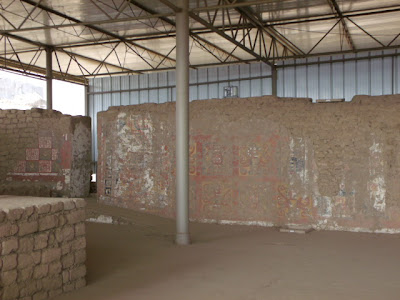Last Saturday - July 7th- I was fortunate to be invited along on a tour of the archaeological sites of Chan Chan and the Huacas de la Luna & del Sol organized by Susana's group/project leader, Douglas Sharon.
Doug is a really interesting fellow. He currently specializes in studying folk healing (curanderismo) and folk use of traditional herbal remedies, but previously he had been an archaeologist. As a teenager he ended up as a lead field team manager on the famed 1964 Savoy Expedition which disproved Hiram Bingham's contention that Machupicchu was the legendary Vilcabamba, the last stronghold of the Incas, and showed that Espíritu Pampa was the actual site of Manco Inca II's rebel capital.
Since then he has returned frequently to Peru and continued studying its traditions. As he told one of the students, "Peru gets ahold of you. You come to Peru, and if you come a second time, then you'll keep coming back."
After visiting Chan Chan (which I'll get to later) and having lunch in Trujillo, we made our way to the southeastern edge of the city to the Campiña de Moche, and to the Huacas de la Luna y del Sol archaeological site at the base of Cerro Blanco peak.
The two Huacas are the remains of large mud-brick pyramids constructed by the ancient Moche (a.k.a. Mochica). The site was a politico-religious complex that served as the capital of the Moche state from the first century B.C.E. until the 8th century C.E.
The Huaca del Sol -which is currently closed to visitors- was constructed in stages, with different rulers expanding it in at least eight different stages. By the time work stopped on it, it consisted of an estimated 130 million adobe bricks contributed by as many as 100 communities, and even at its remaining height of 43 meters by 228 meter length and 138 meter width, it stands as the largest adobe structure ever constructed in America. It was named the Huaca del Sol because it was believed to have been a temple to the Sun, however archaeologists today believe that it may have served as a royal residence.
 |
| Huaca de la Luna, at the base of Cerro Blanco peak. |
The Huaca de la Luna is smaller but better preserved than the Huaca del Sol, which was severely damaged by Spanish looters. It was named Huaca de la Luna in the belief that it was the lunar counterpart to the presumed sun temple at the Huaca del Sol. It was a religious temple but to a pantheon of Moche deities.
I first -and last- visited the Huaca de la Luna in 1972 or 1973, when I was a child. The famed archaeologist and linguist Victor Antonio Rodriguez Suy Suy, who was of Moche ancestry on his mother's side (hence the Suy Suy matronymic), was a friend of my father's and he led us on a tour of the Huaca.
 |
| The painted wall shown to me 40 years ago |
I remember it was bitingly cold and windy day, and that the sand, blown by the wind, stung my bare legs and arms. Suy Suy led us to a portion of wall protruding a couple of feet from the sand and dirt at the top of the mound that was the huaca back then and excitedly pointed out traces of blue and red paint. These newly uncovered traces were the first indication that the huaca, and perhaps many others, far from being earth-colored structures had in fact been brightly painted.
Today, archaelogists have uncoved a series of nested pyramids, each built atop -and entombing- the previous one, and each covered in murals.
Today, archaelogists have uncoved a series of nested pyramids, each built atop -and entombing- the previous one, and each covered in murals.
In fact, one external wall, many meters tall and wide, and facing what would once have been a courtyard or ceremonial plaza, vividly depicts the Moche social order, with prisoners to be sacrificed at the bottom and various deities at the top.
One extraordinary panel in the ceremonial plaza seems to depict the entire Moche cosmography and mythology.
Revisiting the Huaca de la Luna was a neat experience, and it was amazing to see the state of preservation of the murals, as well as the sheer visual impact that they have -specially the large courtyard wall- even faded and damaged as they are. One can easily imagine what it would have been like to see them in their brightly-hued prime, with music blaring and the incantations of Moche priests rebounding off the walls and the stones of Cerro Blanco.
 |
| Ai Apaec, the Decapitator God |







No comments:
Post a Comment